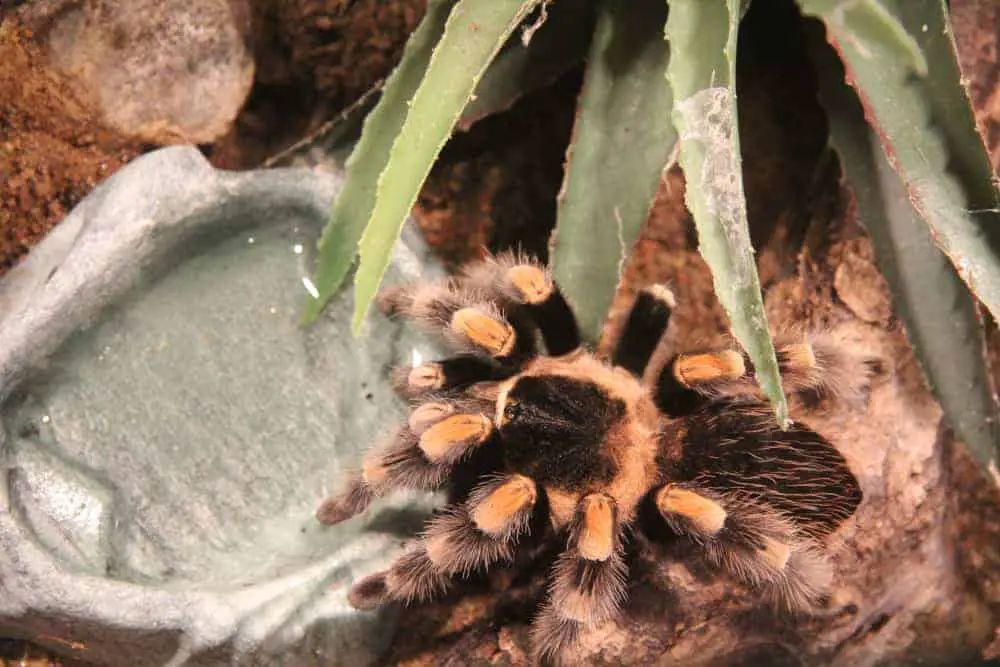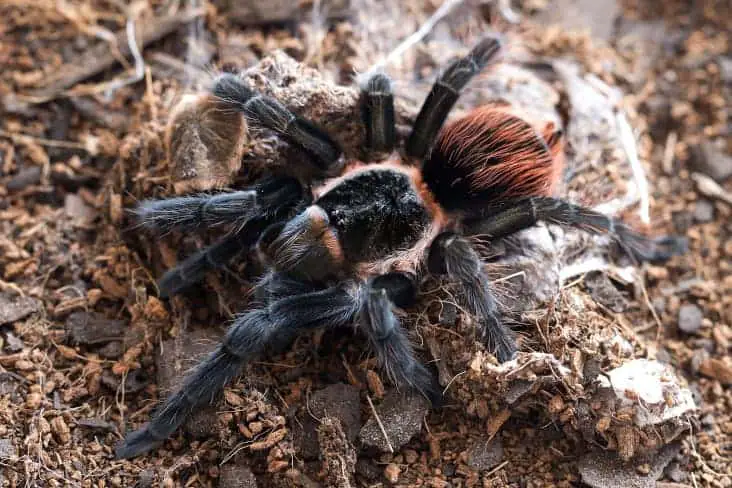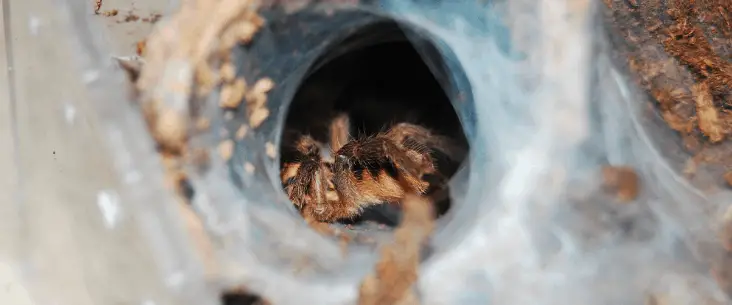Like with every pet, tarantulas need a clean environment too. Although tarantulas are tidy creatures and cleaning is not so frequently needed as for many other pets, there is still a need to clean the enclosure once in a while. However, these spiders don’t like that you poke around in their cage, and can defend themselves when you are not careful. So, how do you clean a tarantula enclosure easy and safe?
When you need to clean the enclosure you have to make good preparations. Preparing all the materials you need and remove the tarantula from the enclosure. A complete cleaning of the enclosure is not always necessary and is not much needed when you do regular spot cleaning.
Cleaning is not difficult, but you need to make proper preparation to minimize the risk that you startle your spider and unnecessary stress them. A startled tarantula can shoot irritating bristles (urticating hairs) or even bite you. In this article, I describe a complete cleaning routine with clear, easy steps. But there is much more to learn about keeping the enclosure clean, so keep on reading!
Cleaning your tarantula enclosure in 8 steps
When you want to make cleaning easy, follow these steps! This will make cleaning practical and will make you prepared, so it is safe for your spider and you.
1. Preparation: What tools do you need to clean a tarantula enclosure?
Prepare, prepare prepare! It is important to make preparations before you start cleaning the enclosure. Make a plan on which materials you need and collect them already before starting to clean. Refreshing the substrate? Make sure you have your new substrate ready-to-use (so if you have a mix of products, mix it in advance).
Also, plan how you are going to remove the spider from the enclosure, and where you want to keep it when you are cleaning the enclosure. Do the cleaning in an area where you don’t have any distractions. Think of playing kids running around or curious pets that want attention. Be sure all the windows and doors of the room you transfer the spider are closed. When your tarantula is moody or (starting to) moult, do the cleaning another day.
Some do the cleaning on the ground in a closed room, others like it to clean the enclosure in the bathroom/bathtub (easy to clean afterwards, and when tarantula escapes it can’t hide that easily). At least it is important to think about where you do the cleaning!
Below a list of materials you probably need for cleaning:
- Garbage bag to throw away any dirt and old substrate
- Brush and soap for cleaning the tank
- Paper towel for drying or removing dirt spots
- Towel to place your terrarium on so it won’t damage during cleaning
- Kitchen gloves to protect hands for urticating hairs in the substrate
- Spoon to dig out the old substrate
- Back-up container to keep your tarantula when cleaning
- Plastic cup to transfer your tarantula to the temporary enclosure
- The prepared substrate to place in the enclosure
When you collected all the materials you want to use and found a good place to clean the enclosure, it is time to remove the tarantula from the enclosure. But, make sure you have already a plan for how you are going to remove your tarantula out of his enclosure.
2. Remove spider out of the enclosure
When you do a complete cleaning of the enclosure, you have to extract the spider from the enclosure. But how you do it, depends on you and on your spider.
Are you comfortable to let the spider crawl on your hand and place it in a temporary enclosure. Then you should do that. But make sure that move your spider close above the ground. When if falls off from a certain height it will injure your spider.
You can also use a small plastic container a carefully guide your spider in it, so you can easily transfer it to its temporary enclosure while you do the cleaning.
Make sure that your temporary enclosure has a simple hide and that it has enough ventilation holes.
3. Remove all the decoration
When you placed your tarantula in a safe location, it is time to remove all the decoration and stuff from your enclosure: plants, hides, water dish, rocks, wood, etc.
Non-organic materials can be cleaned with water and soap. Organic materials, like wood and cork hides, can be reused when not dirty or damaged/rotten. Otherwise, it would be best if you replaced them with new items.
4. Remove the substrate
Then it is time to remove the substrate from the enclosure. You can use a spoon to loosen the substrate carefully or scoop it out. Don’t stir up the substrate too much; otherwise, the urticating hairs will blow up and can sting your skin or eyes. It would be wise to use kitchen gloves because of this reason.
When the substrate is all loose, you can fold the garbage bag around your enclosure and tip all the substrate in the garbage bag. It is important that the garbage bag seals off nicely because of these urticating hairs. When (almost) all substrate is in the bag, immediately close the garbage bag. You can carefully scoop out any remainings.
Never reuse old substrate. It always contains some bacteria and/or fungus and can infect your clean enclosure. Besides that, tarantulas are tidy creatures and don’t like dirty substrate.
5. Cleaning of the tarantula enclosure
Now we can do the actual cleaning of the enclosure. Because you need to clean it completely with (preferably hot) water, it is easy to the cleaning in a bathtub or shower. It makes it easier to clean after than for example a kitchen sink.
Use a small dose of disinfectant soap and a scrubby brush to clean the tank. A detachable showerhead is also a good way to spray out all remaining dirt out of the enclosure. Never use heavy chemical soap to clean the enclosure. These chemicals can be very hazardous to your tarantula when small remains stay in the enclosure (and often will because they are difficult to remove with water).
When your enclosure and decoration items are clean, thoroughly rinse them with (hot) water to be sure you remove all traces of soap. When all cleaned, it is better to air dry your enclosure than dry it with a towel. When you wish to dry the enclosure quicker, use paper kitchen towels — but paper towels can leave paper dust on the windows.
When using sponges, it would be best if you use a new sponge every time you clean. Within a sponge, bacteria will build-up, and you can transfer these bacteria to your enclosure. Instead of cleaning it, you infect your enclosure with new bacteria.
6. Add fresh substrate to the enclosure
Only add the new substrate when the enclosure is dry; otherwise, the substrate will stick on the windows. When you use a loose substrate, it is easy to process. When you use a mix of products or use compressed substrate bricks, you should have it already prepared before you start cleaning.
Make the conditions of the substrate ideal for your tarantula. Not soaking wet, but also not completely dry. The moisture level depends on the species of tarantula you keep.
There is much to learn about the substrate for tarantulas. You can find all you need to know, including practical tips, in the tarantula substrate guide.
7. Redecorate the enclosure
You are almost done. Now you can redecorate and set up the enclosure as your tarantula like it. Place back all the items like hiding(s), plants, wood and the water dish.
Don’t place any heavy items like rocks, because it compacts the substrate and when it falls on your tarantula — for example, when burrowing beneath a rock — will injure or even kill your tarantula.
Your enclosure is completely clean, and it is ready to house your tarantula again. Do just one last inspection if everything is set, and then it is time to introduce your tarantula back to its clean enclosure.
8. Introduce tarantula to clean enclosure
If you have your tarantula in a small container, it is rather easy to reintroduce it to its enclosure. Just place the container in the enclosure and take of the lid. Your spider can walk out by itself.
If you have it placed in a larger temporary container, slowly and carefully nudge them in a small container to transfer back to its enclosure.
Be aware that, generally, your tarantula doesn’t like change. It can be more defensive when you want to house it back into its original enclosure. Just be gentle, careful and take your time.
When you have your spider back in the enclosure, don’t be surprised that it chooses to hide for a couple of days. As said before, tarantulas don’t like change and need some time to acclimate to its new clean environment. Just give it time, and your spider will be back its old self in a little while.

Spot cleaning: What is it, and how do you do it?
Spot cleaning is, like the name suggest, only cleaning certain spots in the enclosure that become dirty quicker than the rest of the enclosure. Spot cleaning include removing leftover food items, dirty water dish, food bolus, old moults or removing fungus patches that are not spread already.
You may ask why you need to do spot cleaning? For the water dish, it is an easy answer: You want to provide clean drinking water to your spider, and it helps to keep the humidity higher. However, removing dirt spots regular between complete cleanings will keep the habitat cleaner, and therefore you don’t need to refresh the entire enclosure frequently. Spot cleaning is more routine-based maintenance.
For spot cleaning, tweezers/tongs are your best friend. You can use it to remove food leftovers, old moults, and tarantula poop. You can also use your tongs to grab a moist paper towel to clean the windows. By using tongs, you don’t stir the habitat too much and won’t destroy all the webbing. Tarantulas don’t like change in their environment, and it can be very stressful when you continuously destroy and remove the webbing.
Another benefit is that you keep a safe distance between your tarantula and you, so you can safely clean without the risk of shooting hairs or a bite.
To clean or not to clean: How often should I clean my tarantula enclosure?
When do you need to clean the enclosure? Many tarantula keepers that are new to the hobby question how often they should clean it.
Tarantulas are tidy creatures and don’t need much maintenance. That’s one reason why they make such great pets. Besides that, tarantulas don’t like that you disturb there environment too often. In this section, we discuss how often you should clean the enclosure.
How often should I spot clean my tarantula enclosure?
There are two types of cleaning: spot cleaning and deep cleaning (or total cleaning). How often you should spot clean the enclosure depends how much dirt your tarantula produce.
We already said that tarantulas are tidy creatures. For example, food remains and poop can often be found on the same spot. Many tarantulas collect dirt and place it on a pile. Poop can also be found on only one spot in the enclosure.
That makes it rather easy to clean. Spot cleaning is often necessary at least every 2 or 3 days, but when you have a tarantula that is quite calm, you can even remove dirt daily from the enclosure. The same is with the water dish. Best is to refresh the water dish daily. If your tarantula is rather skittish, you could only fill the dish with water, and every 3 days take it out to clean it.
Some tarantulas throw dirt, bolus and food leftovers in the water dish. In that case, you should clean the water dish more often.
How often should I change my tarantula’s bedding?
If you take good care of the substrate, you don’t have to replace it very often. A substrate can last for 6 months up to one year. So a total cleaning, where you replace the substrate, is only done very few times.
It is even not recommended to refresh the substrate more often. Tarantulas don’t like to have fresh substrate every time and that there burrow or webbing is completely destroyed.
So, you should keep it clean, but not excessively clean. When you maintain your substrate in good condition and do regular spot cleaning, then your substrate can easily be kept for a year.

A cleaning routine
Try to make a cleaning routine that fits for your tarantula and your situation. If your tarantula is calm, remove dirt and poop every day. Does your tarantula throw dirt in the water dish? Refresh it every day.
Is your tarantula more skittish? Then only refill the water dish and clean the water dish every 4 to 7 days (depending on how dirty it is). And spot cleaning can also be done less frequently, like once a week.
It can be smart to keep a log when you have done certain cleaning sessions, so you know when you did something for the last time. Especially when you have multiple tarantulas, it can be good practice to note special events, like larger cleaning sessions and removal of moults.
| Task | Frequency |
|---|---|
| Refill water dish | Every day |
| Clean water dish | Every 1 to 7 days |
| Remove food leftovers | 1 day after feeding |
| Spot cleaning | Every 3 to 7 days |
| Clean windows | Every 1 to 6 months |
| Refresh substrate / completely clean enclosure | Every 6 to 12 months |
| Remove moults | After completely moutled |
Do you need to remove your tarantula for cleaning?
When you want to refresh the substrate of your enclosure, you need to remove the tarantula. You can’t clean it when it is still in its enclosure. However, with spot cleaning, you don’t need to remove your spider.
With spot cleaning, you generally leave your tarantula in the enclosure. You work around the animal. Removing the spider every time you do spot cleaning can be very stressful for your animal. Oftentimes it will get more skittish over time and will eventually flick hairs at you quicker, or even try to bite you.
But, keep in mind that your spider also not like that you in his territory. You can make your tarantula aware that you start cleaning by tapping a few times on the wall of the enclosure. Your tarantula will move into his burrow or hide, and you have space to quickly and carefully clean the enclosure.
Does your spider really not like that you clean the enclosure, or that you see it is really stressed, you have to consider not to clean that often, and that your enclosure is a bit dirtier. Maybe you need to do a complete cleaning more often, like once every 4 months. But, between cleanings leave your spider alone.
Want to know more?
This article is only about the cleaning of a tarantula enclosure. But, there is much more to learn when you want to keep a tarantula as a pet. Go check out our basic care guide for keeping tarantulas. It is packed with all the basics you need to know and contains many practical tips.
If you like to know more about the best substrate for tarantulas, you have to read the tarantula substrate guide! Besides discussing all types of substrates, it contains many valuable tips and tricks to have the best substrate for your pet tarantula.
Share this page!



